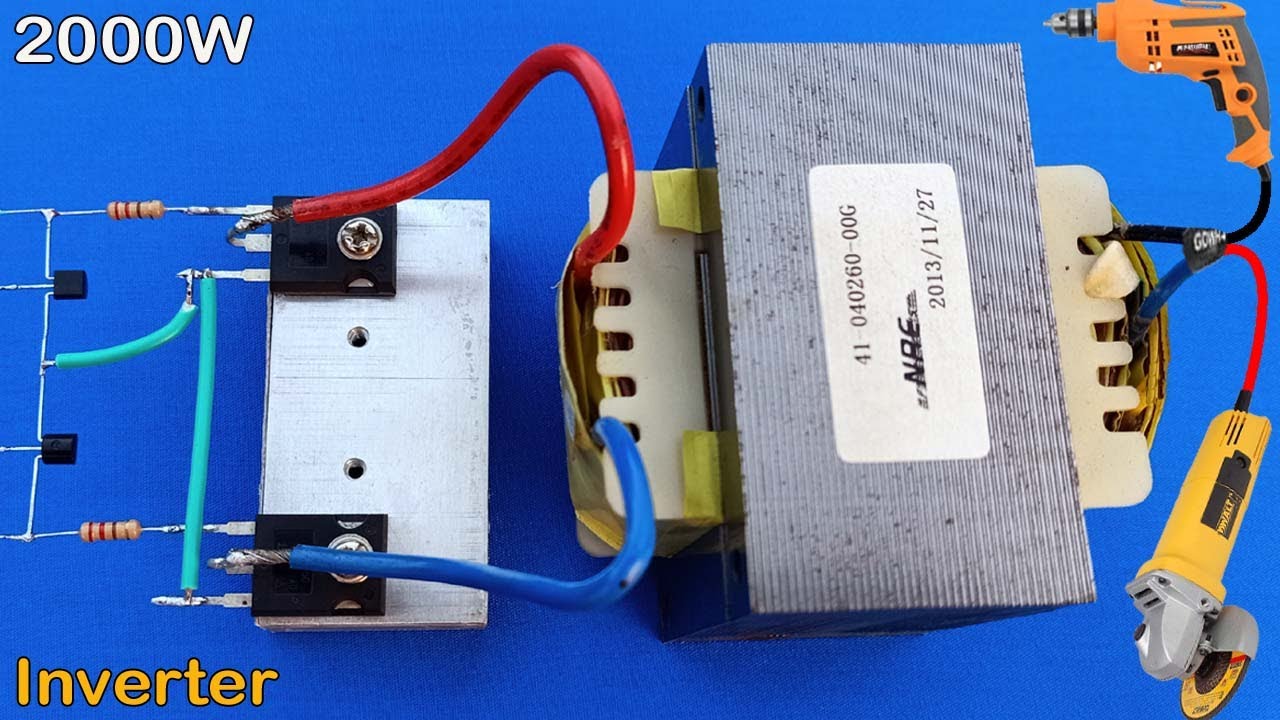through the process of building an inverter circuit for your DIY projects. An inverter is an electronic device that converts DC power to AC power, which is essential for running AC-powered devices using a battery. With our step-by-step instructions and easy-to-follow diagrams, you'll be able to build your own inverter circuit and power your DIY projects in no time.
What is a Simple Inverter
An inverter which uses minimum number of components for converting a 12 V DC to 230 V AC is called a simple inverter. A 12 V lead acid battery is the most standard form of battery which is used for operating such inverters.
Let's begin with the most simplest in the list which utilizes a couple of 2N3055 transistors and some resistors.
1) Simple Inverter Circuit using Cross Coupled Transistors
The article deals with the construction details of a mini inverter. Read to know regrading the construction procedure of a basic inverter which can provide reasonably good power output and yet is very affordable and sleek.
There may be a huge number of inverter circuits available over the internet and electronic magazines. But these circuits are often very complicated and hi-end type of inverters.
Thus we are left with no choice but just to wonder how to build power inverters that can be not only easy to build but also low cost and highly efficient in its working.
After the above wiring is completed, it's time to hook it up with a 12V 7Ah battery, with a 60 watt lamp attached at the transformer secondary. When switched ON the result would be an instant illumination of the load with an astonishing brightness.
Here the key element is the transformer, make sure the transformer is genuinely rated at 5 amp, otherwise you may find the output power a lot lesser than the expectation.
I can tell this from my experience, I built this unit twice, once when I was in college, and the second time recently in the year 2015. Although I was more experienced during the recent venture I could not get the awesome power that I had acquired from my previous unit. The reason was simple, the previous transformer was a robust custom built 9-0-9V 5 amp transformer, compared to the new one in which I had used probably a falsely rated 5 amp, which was actually only 3 amp with its output.
through the process of building an inverter circuit for your DIY projects. An inverter is an electronic device that converts DC power to AC power, which is essential for running AC-powered devices using a battery. With our step-by-step instructions and easy-to-follow diagrams, you'll be able to build your own inverter circuit and power your DIY projects in no time.
What is a Simple Inverter
An inverter which uses minimum number of components for converting a 12 V DC to 230 V AC is called a simple inverter. A 12 V lead acid battery is the most standard form of battery which is used for operating such inverters.
Let's begin with the most simplest in the list which utilizes a couple of 2N3055 transistors and some resistors.
1) Simple Inverter Circuit using Cross Coupled Transistors
The article deals with the construction details of a mini inverter. Read to know regrading the construction procedure of a basic inverter which can provide reasonably good power output and yet is very affordable and sleek.
There may be a huge number of inverter circuits available over the internet and electronic magazines. But these circuits are often very complicated and hi-end type of inverters.
Thus we are left with no choice but just to wonder how to build power inverters that can be not only easy to build but also low cost and highly efficient in its working.
After the above wiring is completed, it's time to hook it up with a 12V 7Ah battery, with a 60 watt lamp attached at the transformer secondary. When switched ON the result would be an instant illumination of the load with an astonishing brightness.
Here the key element is the transformer, make sure the transformer is genuinely rated at 5 amp, otherwise you may find the output power a lot lesser than the expectation.
I can tell this from my experience, I built this unit twice, once when I was in college, and the second time recently in the year 2015. Although I was more experienced during the recent venture I could not get the awesome power that I had acquired from my previous unit. The reason was simple, the previous transformer was a robust custom built 9-0-9V 5 amp transformer, compared to the new one in which I had used probably a falsely rated 5 amp, which was actually only 3 amp with its output.
























No comments:
Post a Comment